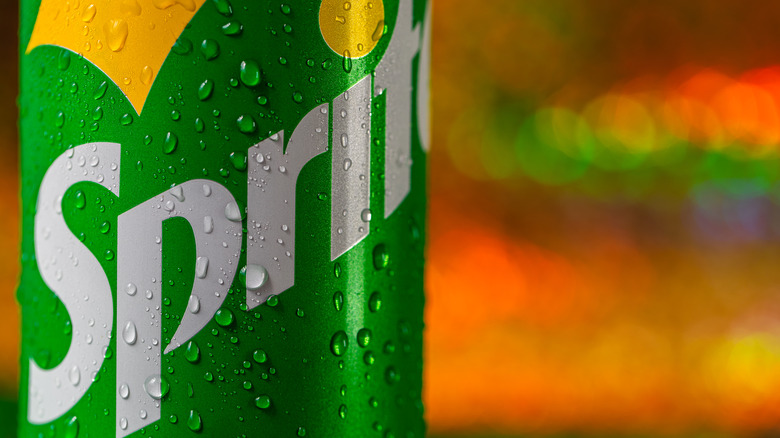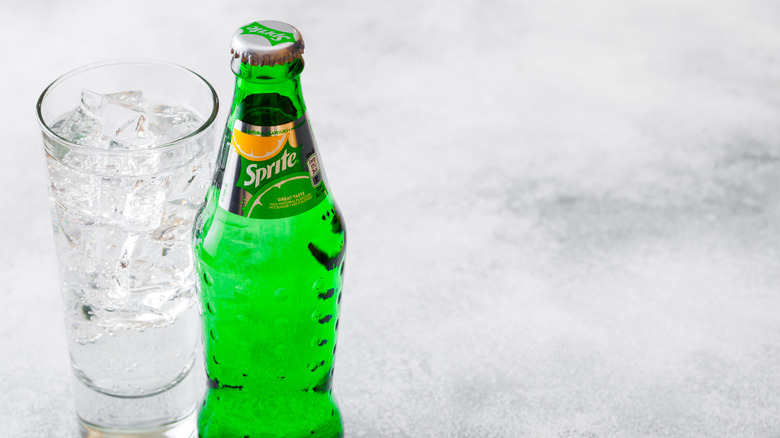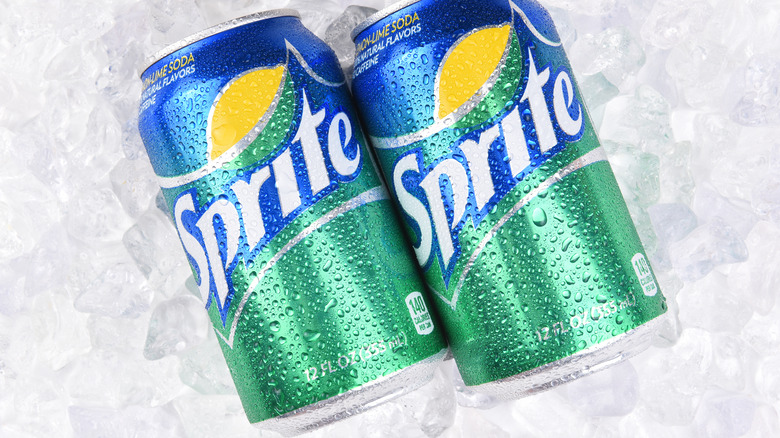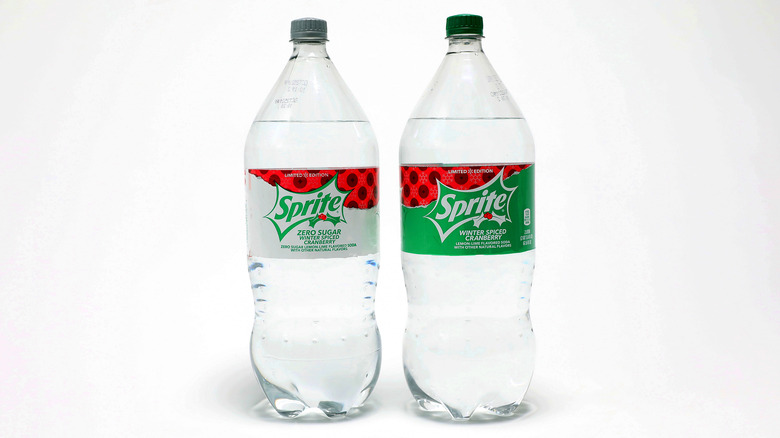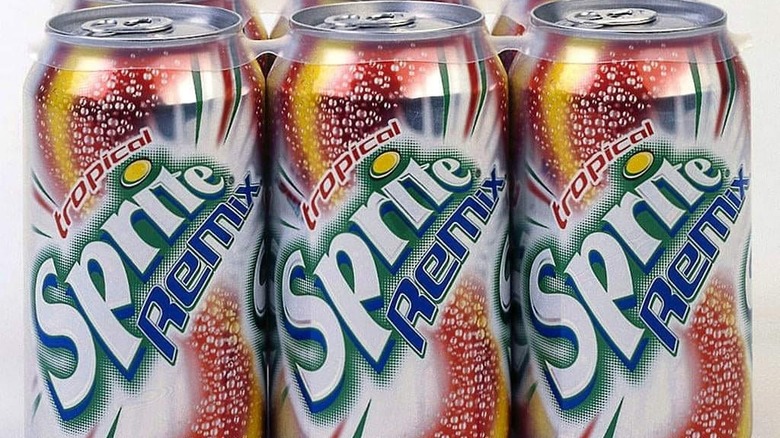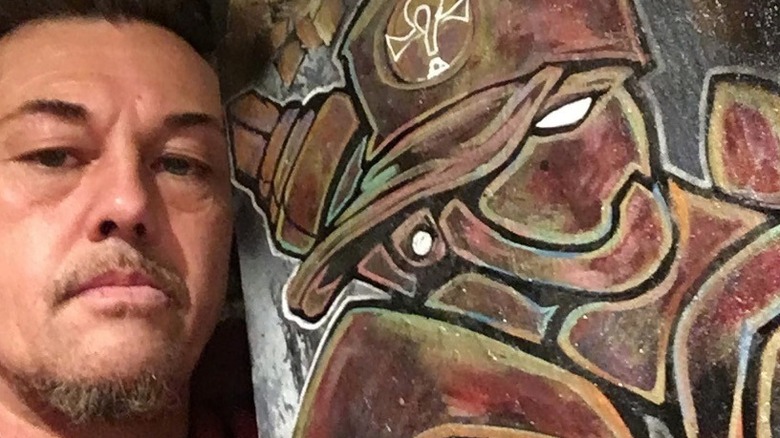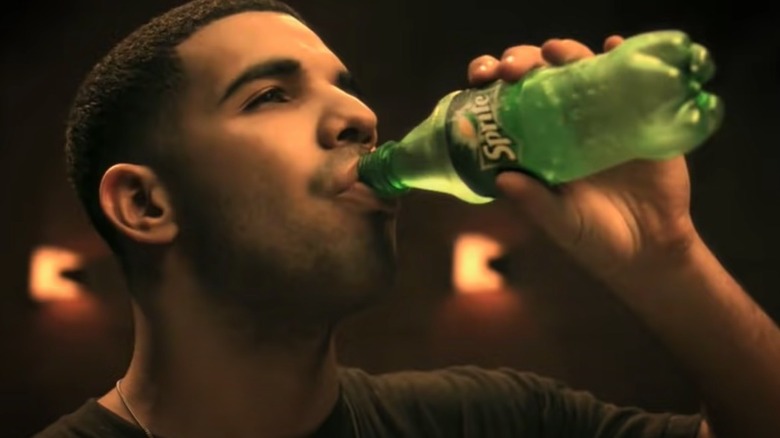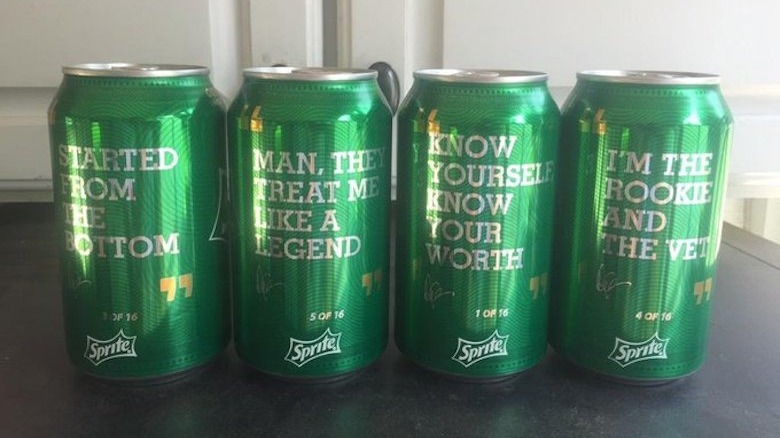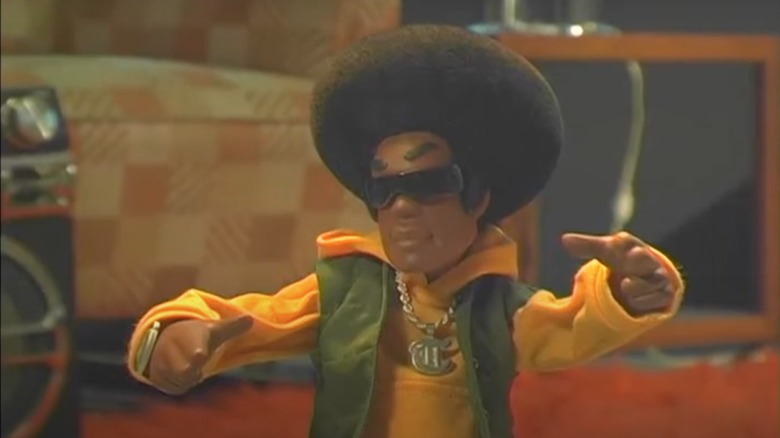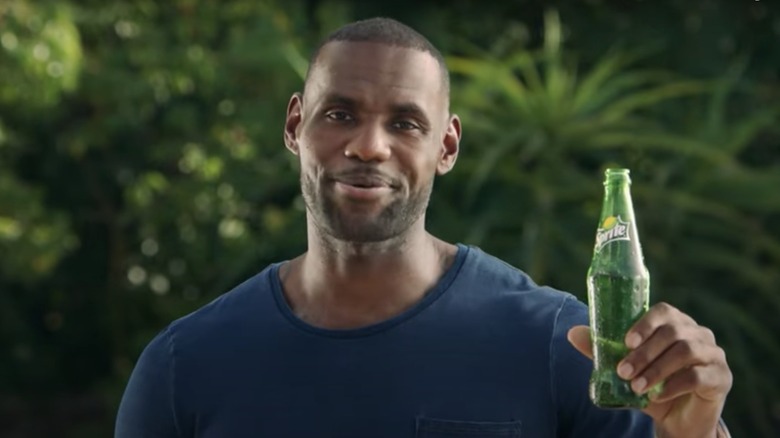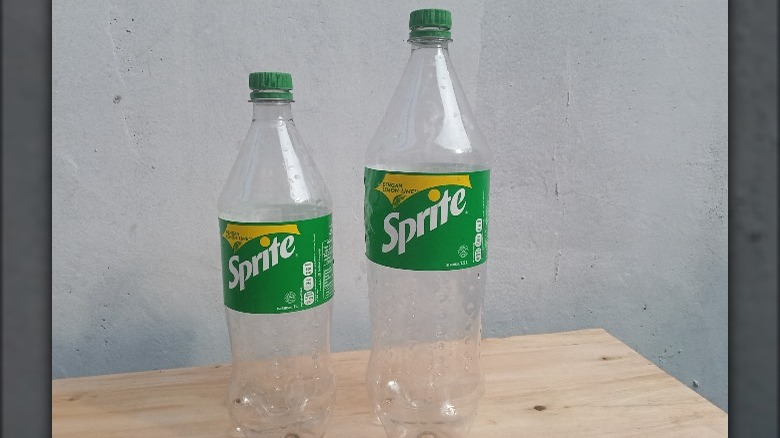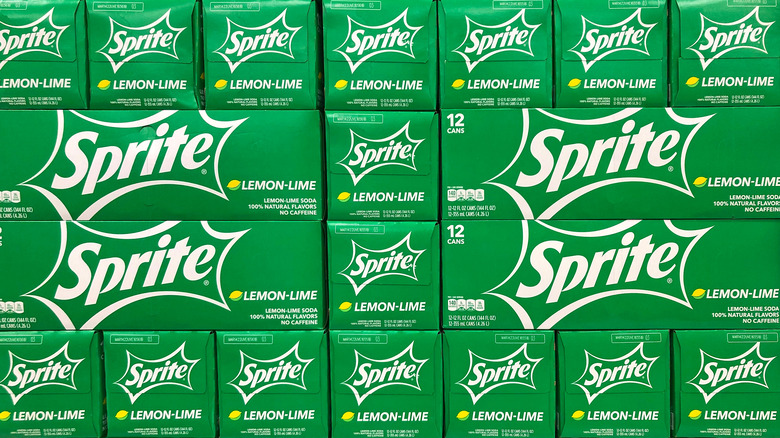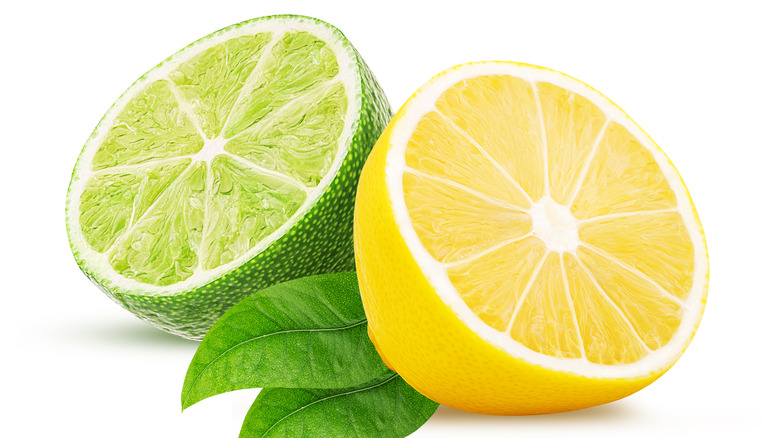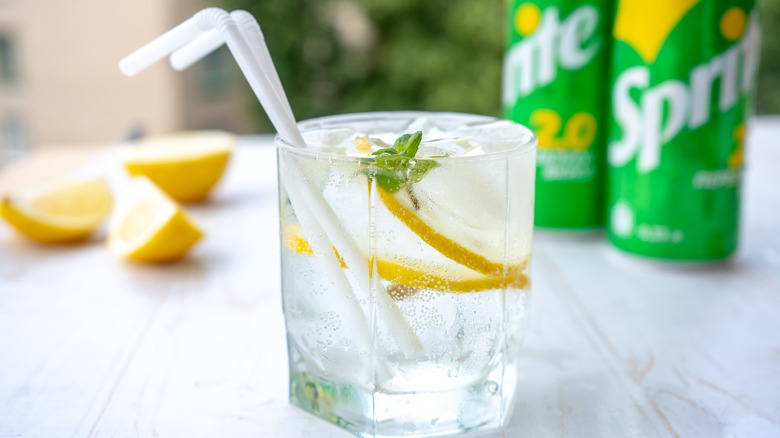The Untold Truth Of Sprite
Among the multitude of carbonated soft drinks, Sprite continues to hold its own. First developed back in the late 1950s, the clear colorless soda proved to be a refreshing alternative to colas and root beers due to a flavor profile combining the tart sweetness of lemon and lime. That combo was dubbed "ly'mon" by the brand's marketing gurus and highlighted in TV commercials at the time. The underlying message to consumers was that "ly'mon is why more people think Sprite is better than 7Up," Sprite's chief competitor.
During the course of all the decades since its invention, Sprite has remained popular with consumers. In fact, the brand's corporate owner Coca-Cola has managed to continually reinvent Sprite for new generations, thanks to clever and often star-studded advertising campaigns enlisting some of the world's most famous folks. Despite the soda's ubiquity throughout the past six decades, there's a lot that those who enjoy the beverage may not know about it. To discover the ins and outs of this celebrated soft drink, keep reading for a deep dive into the untold truth of Sprite.
Sprite wasn't originally an American product
Unbeknownst to many, the origins of Sprite can be traced back to Germany. According to the Rock Hill Coca-Cola Bottling Company, Sprite was developed in West Germany back in 1959 by German soda manufacturer Fanta. In fact, its original name wasn't Sprite, notes Snack History, but Fanta Klare Zitrone (which translates to clear lemon Fanta). The Sprite name wasn't used until the product was introduced into the American market two years later.
According to Snack History, Coca-Cola's designers and engineers did plenty of research before arriving at the logo and design, with numerous designs considered and ultimately rejected. Green was quickly determined to be the right color for the product, both standing out and blending in as a natural tone. The efforts paid off when Sprite was launched to U.S. consumers in 1961, becoming an immediate success.
By 1967, more than three-quarters of American consumers were purchasing Sprite, and it was being sold in nearly 40 different countries around the world — a number that approached 200 by 2019. The first marketing efforts were made towards adults, but as the soda became increasingly popular with teenagers, the focus turned to younger consumers. As Snack History points out, Sprite is currently the planet's third most consumed soft drink.
Sprite may be effective in battling hangovers
The history of Sprite may extend back to the late 1950s, but it wasn't until several decades later that a previously unknown property of the carbonated drink came to light. United Press International reported on a 2013 study undertaken by researchers in China, which found that drinking Sprite might relieve the effects of a hangover. The study was published in the journal Food & Function and examined 57 possible hangover cures to gauge their effectiveness when it came to abating the chemical reaction responsible for hangovers.
In the study, the researchers confirmed that excessive drinking causes an enzyme called alcohol dehydrogenase (ADH) to convert ethanol into acetaldehyde, which is the culprit behind typical nausea and headache symptoms associated with hangovers. A different enzyme, however, dehydrogenase (ALDH), converts acetaldehyde into acetate, diminishing the effects of a hangover. Sprite was found to speed up the acetaldehyde-to-acetate conversion process; as a result, downing a few cans of Sprite after a booze-filled evening could make the following morning a little less painful.
Sprite's formula had to be altered in Britain
American Sprite lovers visiting Britain in the past may have noticed that the U.K. version had a different taste, and there's a good reason for that. Back in 2013, Beverage Daily reported that the British arm of Coca-Cola — which manufactures Sprite — reformulated the classic recipe. While the previous version was sweetened entirely with sugar, the new formula reduced the amount of sugar while adding stevia, a plant-based natural sweetener. According to a spokesperson, the new stevia-sugar combo reduced the sugar content by 30% and was part of a company-wide anti-obesity campaign aimed at "raising awareness of low and no calorie alternatives."
Five years later, the formula for British Sprite changed again. According to a 2018 report in Beverage Daily, the new recipe eliminated stevia entirely while cutting the amount of sugar in half. Unlike the earlier rejigging, however, this change wasn't intended to combat obesity but to avoid paying a sugar tax that the U.K. government introduced in 2017. By reducing the sugar content from 6.6 grams per 100 milliliters to 3.3 grams, Coca-Cola was able to avoid the tax, which applied to any beverage with more than 5 grams of sugar per 100 milliliters.
There have been a lot of different Sprite flavors over the years
While the lemon-lime flavor profile of Sprite hasn't changed considerably since the drink's invention in the late 1950s, that's not to say there haven't been numerous attempts to offer alternate flavored varieties. For example, during the 2021 holiday season, Coca-Cola offered up its popular Winter Spice Cranberry flavor, in addition to a zero-sugar version in response to consumer requests. According to a company press release, the Winter Spice Cranberry flavor was first introduced in 2019, updating the Sprite Cranberry variety that had been "a seasonal staple since 2013."
Of course, those holiday varieties are far from the only flavored versions of Sprite introduced over the years. Ranker offers a handy guide, listing and rating the assortment of drinks, with the old-school original formula remaining the favorite. Other flavors include tropical mix, cherry, peach, grape, raspberry, orange, and vanilla. Less typical options such as Sprite Blast (a limited-edition variety introduced in 2014), Sprite 3G (a "nice-tasting energy drink" that flopped with consumers), Sprite Duo (a Spanish soda with less sugar and carbonation but extra lemon juice), and Sprite on Fire (a ginger-enhanced flavor introduced in China and Hong Kong in the early 2000s) were also on the market for variable durations.
The Sprite Remix expansion flopped with consumers
While Sprite remains popular with consumers, not every attempt to refresh the brand has been successful. One of Sprite's most notorious flops was Sprite Remix, highlighted in a retrospective report by ABC 11 Eyewitness News. As the report notes, Sprite Remix launched in 2003 with three flavors: Tropical Remix, Berryclear Remix, and Aruba Jam Remix. Sluggish sales led Coca-Cola to discontinue Sprite Remix in 2005. However, that wasn't the end. In 2016, Coca-Cola decided to revive one of those flavors, and Sprite Tropical Remix rose like a fizzy phoenix with a new name — Sprite Tropical Mix — a limited-edition offering for the summer.
"Fans have thirsted for the return of this popular Sprite tropical flavor for years, and it's great to finally bring it back to reward their enthusiasm. I can't think of a better way to let them know that we're listening," said Kimberly Paige, vice president of Sprite and Flavors for Coca-Cola North America, in a press release (via BevNet). While the Tropical Mix flavor never returned after that, an online petition called for the return of Tropical Remix to the marketplace. "If they still sell Tab, they should still produce, distribute and sell the Remix," declared the petition's founder.
A popular graffiti artist once designed limited-edition cans of Sprite
In 2001, Sprite embarked on an effort to add some artistic street cred to its brand by enlisting the talents of Arron Bird, an up-and-coming British graffiti artist known as Temper. According to EuroNews, Temper was hired by Coke to design a limited-edition Sprite can featuring his distinctive art. Being commissioned by Coca-Cola proved to be the launching pad that put Temper on the map, particularly when his design proved to be a hit with consumers.
As Temper declared in an interview with BBC News, "It was the most successful designer can they've had in the U.K." KidzWorld reports that the cans were only available to British Sprite drinkers for four months; in addition, they were part of a larger campaign devoted to supporting street culture, in association with the Sprite Urban Games. Temper viewed the collaboration with Sprite as a huge step towards validating graffiti as a legitimate art form in Britain. "It changed graffiti in this country, it was a big company taking a stand with the art form," he told the Express & Star.
Sprite has a long history with hip hop
Ever since the marketing and advertising gurus tasked with selling Sprite came to realize that they should be tapping into the teenage demographic, the brand has been associated with what's young and cool. It was that philosophy, described in an article by Coca-Cola Australia, that led to Sprite's association with hip-hop music. In fact, the article notes that the relationship extended all the way back to the early days of the genre when Sprite sponsored rapper Rakim.
The big breakthrough, however, came when Sprite cast rapper Kurtis Blow to appear in a TV commercial for the soda in the late 1980s. Since then, Sprite has enlisted the likes of LL Cool J, Drake, and A Tribe Called Quest for its advertising campaigns. "Music is important and plays a role in all of our lives," says Bobby Oliver, one-time director of Sprite & Citrus Brands, Coca-Cola North America. "Sprite realized this dating back to the 1980s and in hip-hop, there was a power of creativity in this new form that was really resonating with the population. We embraced that and ingrained ourselves as part of that culture."
Sprite cans were once adorned with rap lyrics
Sprite took its association with rap even further in 2015 when the brand unveiled a series of limited-edition cans, each of which featured the rap lyrics of four iconic rappers: Nas, Drake, Rakim, and The Notorious B.I.G., a.k.a. Biggie Smalls. As Pitchfork reported at the time, a Sprite press release explained that those particular rappers were selected "based on their reputation for being true to themselves through their music and advancing the culture."
Delish notes that the campaign was titled "Obey Your Verse," a twist on Sprite's famed advertising tag line "Obey Your Thirst." Among the lyrics to make it onto the cans were: "Man, they treat me like a legend" from Drake's "Over," "Speak the truth" from Rakim's "Waiting for the World to End," and The Notorious B.I.G. line "Lyrically I'm supposed to represent" from the late rapper's 1994 hit "One More Chance."
In a press release reported by Pitchfork, Nas shared his thoughts regarding the impact that having his lyrics on a can of Sprite would have on his legacy. "I never imagined my fans would someday have the opportunity to enjoy a can of Sprite and experience my art in a totally original way," he mused.
Sprite mascot Miles Thirst was a problematic failure
Sprite's long and lucrative association with hip-hop also led to one of the brand's most notorious missteps. That came in 2004 with the introduction of Miles Thirst, a tiny doll who would serve as the Sprite mascot in a series of TV commercials. Described by USA Today as "a 10-inch vinyl doll decked out in baggy jeans, gold chain and stylish kicks such as white, Adidas-style sneakers or Timberland boots," Miles Thirst was created with an important intention: reversing a drop in Sprite sales from the previous five years.
While Miles was intended, according to USA Today, as a "pop icon firmly entrenched in hip-hop culture," the launch of the character — who not only appeared in commercials but was also a doll that could be purchased — did not go smoothly. Per the Wall Street Journal, Rev. Jesse Jackson, founder of the discrimination watchdog group the Rainbow/Push Coalition, criticized Sprite for creating a character that "reinforces stereotypes" about African-Americans.
A little over a year later, according to the Sports Business Journal, Sprite scuttled its imaginary pitchman. As Brandweek's Kevin Hein explained, Miles Thirst "angered some advocacy groups and at the same time failed to grow sales."
Sprite has enlisted some of the NBA's top stars for ad campaigns
As it turned out, not everything about the Miles Thirst ad campaign was a total bust. In the initial commercials, the Marketing Case Studies blog notes that Miles teamed up with NBA star LeBron James while launching the soda brand's new slogan, "Obey Your Thirst." While Sprite may have ditched Miles, both King James and the tagline remained. James even signed a six-year deal with Sprite in 2003 when he was just 18. "I have been drinking Sprite and Powerade for a long time," James said in a statement reported by Cleveland's 19 News, adding that "I have always admired the way Sprite and Powerade spoke to young people and athletes, and I can't wait to be a part of it."
In fact, James is just one of many professional basketball players to have appeared in advertising campaigns for Sprite. Back in the 1990s, Sprite enlisted NBA stars Grant Hill and Tim Duncan for a TV spot referencing the NBA lockout during the '98-'99 season. The two appeared in a faux TV commercial for 1-800-Tall-Men, offering to rescue cats from roofs and change the lightbulbs in chandeliers.
Greenpeace had a bone to pick with Sprite
Sprite has never really established a reputation as a controversial soft drink, but that's not to say the soda has managed to entirely avoid issues. In 2018, environmental advocacy group Greenpeace took Sprite to task, explaining how the refreshing soft drink was connected to deforestation in Argentina. Greenpeace alleged that the lemon flavor used in Sprite comes from concentrated lemon juice from Argentinian citrus exporter La Moraleja S.A., claiming the company's methods led to the deforestation of 3,000 hectares in the South American nation. Furthermore, Greenpeace declared that the company's actions were illegal and the corporation even knew about the illegality — but didn't care.
That isn't the only issue that Greenpeace has had with Sprite: As Kenya's Capital Business reported in 2021, Coca-Cola responded to the African nation's attempts to limit the use of plastics by introducing new clear Sprite bottles made from polyethylene terephthalate, which can be more easily recycled than green plastic bottles. However, Greenpeace Africa's senior political advisor Fredrick Njehu slammed the effort, telling Taarifa News that the whole thing was "nothing short of greenwashing," and displayed "total disregard of efforts to curb plastic pollution in our environment."
Sprite was part of a 2021 product recall
Various consumer products have been forced to issue recalls, and Sprite has not been immune. In 2021, the Defense Commissary Agency reported that Coca-Cola had voluntarily issued a recall of a "limited quantity" of 12-ounce cans of Coke and Sprite "due to the potential presence of foreign matter."
As Food Safety News reported, those cans were feared to contain metal washers or bolts, with the U.S. Food and Drug Administration declaring that the recall applied to products that were shipped to several states including Maine, Pennsylvania, New Jersey, Connecticut, New York, North Carolina, Maryland, and Virginia. What made the issue particularly pressing was that both Sprite and Coke have such long shelf lives, extending well into the following year. As a result, Taste of Home recommended that consumers take a look at their soda supplies to check whether any boxes were labeled with the specific date codes that were being recalled.
There are recipes to make homemade Sprite
Given that Sprite is the third most consumed soda in the world, it would be a rare occurrence to find yourself in a location where Sprite couldn't be easily found. However unlikely, it is possible, and for those hardcore Sprite drinkers who may not want to take a chance missing out on their favorite beverage, there are some recipes online that share step-by-step instructions to whip up a batch of homemade Sprite.
For example, I Really Like Food! offers an easy recipe for DIY Sprite, requiring only three ingredients: a lemon or some lemon juice, a bit of sugar, and a bottle of lime-flavored sparkling water. The concoction is made by mixing up 2 tablespoons of lemon juice with 3 tablespoons of sugar in a glass and then pouring in the sparkling water. A slightly more sophisticated variation is also offered, substituting simple syrup for sugar. In both cases, amateur soda makers are encouraged to customize the amount of sugar and lemon juice to their taste.
Sprite is a key ingredient in an array of cocktails
Given that Sprite has been a popular and familiar brand in the soda category for so many decades, it shouldn't be surprising that the clear, lemon and lime soft drink has been utilized by bartenders in numerous cocktails. The citrusy mixer is subtle enough to pair nicely with an assortment of spirits, and as mentioned, it's easily accessible all over.
Mix that Drink suggests trying Sex on the Driveway, a variation on Sex on the Beach, that is comprised of blue curacao, peach schnapps, vodka, and Sprite. Then there's Bar None Drinks, which lists over 300 different cocktails featuring Sprite as a component, ranging from the 007 (which combines orange juice, Sprite, and Stolichnaya orange-infused Ohranj vodka) to the cheekily named You Forgot to Flush, a mixture of bright-yellow Galliano and Sprite. Meanwhile, Cosmopolitan offers a more bespoke list of Sprite-enhanced cocktails, including such boozy libations as the Vodka Cranberry Cocktail, the Dirty Shirley (a liquored-up variation of a Shirley Temple, but adding vodka), and the GinInnJuice, which combines Inniskillin Vidal ice wine with gin and peach nectar, topped with a float of Sprite.
